It looks like there is a better answer here: Sql Sum of child Items but my sql skills weren't up getting that one to work. my solution uses a calculated field based on an isChild function. 1. add a code module using the create tab on the ribbon
Public Function isChild(ParentID As Long, ChildID As Long) As Long
'a Parent is considered their own child to simplify calculations.
Dim Parent, i As Long 'loops i generations to protect against infinite loops
Parent = ChildID
Do Until (Parent = ParentID) Or (Parent = 0) Or (i = 20)
Parent = Nz(DLookup("PrntEntityID", "TblEntity", "EntityID = " & Parent), 0)
i = i + 1
Loop
If i = 20 Or Parent = 0 Then
isChild = 0
Else
isChild = 1
End If
End Function
qryParentsChildren crosses all combination of EntityID and then uses isChild to determine if the Parent Child combination works. In the query designer drag tblEntity twice and make sure there is no relationship arrow between tblEntity and it's dupe tblEntity_1.

'sql
SELECT tblEntity.EntityID AS Parent, tblEntity_1.EntityID AS Child, isChild([tblEntity].[EntityID],[tblEntity_1].[EntityID]) AS isChild
FROM tblEntity, tblEntity AS tblEntity_1
WHERE (((isChild([tblEntity].[EntityID],[tblEntity_1].[EntityID]))=1))
ORDER BY tblEntity.EntityID, tblEntity_1.EntityID;
----------------------------------------------------------------
| Parent | Child | isChild |
----------------------------------------------------------------
| 1 | 1 | 1 |
----------------------------------------------------------------
| 1 | 2 | 1 |
----------------------------------------------------------------
| 1 | 3 | 1 |
----------------------------------------------------------------
| 1 | 4 | 1 |
----------------------------------------------------------------
| 1 | 5 | 1 |
----------------------------------------------------------------
| 1 | 6 | 1 |
----------------------------------------------------------------
| 2 | 2 | 1 |
----------------------------------------------------------------
| 2 | 4 | 1 |
----------------------------------------------------------------
| 2 | 5 | 1 |
----------------------------------------------------------------
| 2 | 6 | 1 |
----------------------------------------------------------------
| 3 | 3 | 1 |
----------------------------------------------------------------
| 4 | 4 | 1 |
----------------------------------------------------------------
| 4 | 5 | 1 |
----------------------------------------------------------------
| 4 | 6 | 1 |
----------------------------------------------------------------
| 5 | 5 | 1 |
----------------------------------------------------------------
| 6 | 6 | 1 |
----------------------------------------------------------------
Open the query designer again and add qryParentsChildren and tblEntity. In the query designer right click to get the context menu and select totals to set up a standard totals query:

'sql
SELECT qryParentsChildren.Parent AS EntityID, tblEntWdg.Widget, Sum(tblEntWdg.Qty) AS Qty
FROM qryParentsChildren INNER JOIN tblEntWdg ON qryParentsChildren.Child = tblEntWdg.EntityID
GROUP BY qryParentsChildren.Parent, tblEntWdg.Widget;
----------------------------------------------------------------
| EntityID | Widget | Qty |
----------------------------------------------------------------
| 1 | W1 | 2 |
----------------------------------------------------------------
| 1 | W2 | 10 |
----------------------------------------------------------------
| 1 | W3 | 4 |
----------------------------------------------------------------
| 1 | W4 | 1 |
----------------------------------------------------------------
| 1 | W5 | 5 |
----------------------------------------------------------------
| 1 | W6 | 2 |
----------------------------------------------------------------
| 2 | W1 | 2 |
----------------------------------------------------------------
| 2 | W2 | 10 |
----------------------------------------------------------------
| 2 | W3 | 4 |
----------------------------------------------------------------
| 2 | W4 | 1 |
----------------------------------------------------------------
| 2 | W6 | 2 |
----------------------------------------------------------------
| 3 | W5 | 5 |
----------------------------------------------------------------
| 4 | W1 | 2 |
----------------------------------------------------------------
| 4 | W2 | 10 |
----------------------------------------------------------------
| 4 | W3 | 4 |
----------------------------------------------------------------
| 4 | W4 | 1 |
----------------------------------------------------------------
| 5 | W1 | 1 |
----------------------------------------------------------------
| 5 | W2 | 5 |
----------------------------------------------------------------
| 5 | W3 | 2 |
----------------------------------------------------------------
| 6 | W1 | 1 |
----------------------------------------------------------------
| 6 | W2 | 5 |
----------------------------------------------------------------
| 6 | W3 | 2 |
----------------------------------------------------------------
these results are slightly different than your expected output but seem correct based on the sample data and my understanding of the question

